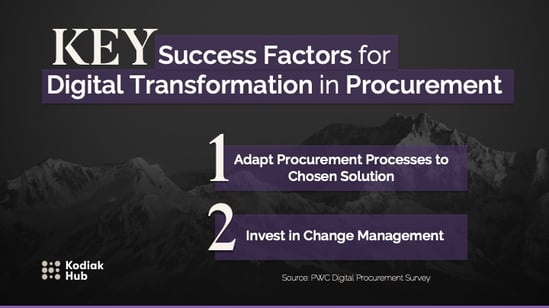Last week I read an insightful report by PwC; the 2020-’21 Digital Procurement Survey.
One of the key findings really resonated with me.
“Among the key success factors for digital transformation projects, adapting procurement processes to the chosen solution and investing heavily in change management are identified as major factors, while the choice of technology or integrator is less important” (PWC 2020).
These findings make it apparent that without a willingness to adopt new processes and invest in change management, digital transformation is difficult within procurement or any function for that matter.

A common misconception when it comes to digital transformation is that procurement processes and data sets need to be in perfect shape and well-aligned with the technology you adopt. Technological capacity and maturity shouldn’t be bunched together with having good supplier quality data.
The application and adoption of procurement technology are only as transformational as the people you have in your procurement department.
Technology offers a vehicle to work smarter, but people pave the road to change.
7 Steps to Jumpstart Procurement Digital Transformation
Digital Transformation doesn’t happen overnight. It also doesn’t happen without ensuring that there are drivers for change in place.
Ultimately the steps for digital transformation are dependent on having a team, steering group, project leadership, or program management in place that will lead the charge towards change.
Some steps that every procurement organization (inspired by this article from Archerpoint) should take in order to simplify the digital transformation process are as follows:
1. Create a Culture for Change
Don’t be afraid to fail, think iteratively, and create a collaborative (flatter) organization where feedback and insight sharing is welcomed.
2. Assess Your Present State
Run GAP/SWOT Analysis or alike activities to understand where you’re at, and where you may want to be.
3. Identify Areas of Potential Change
Spot the existing parts of your process that need to be redesigned/improved upon.
4. Market Exploration
See what’s out there on the market. Meet with prospective vendors, see demos, ask questions and gather findings.
5. Identify Prospective Technology Vendors
Map out vendors against your ideal roadmap and begin to shortlist vendors.
6. Build Your Case for Budget
Build your business case, get Leadership on your side, and apply for funding to receive necessary resources.
7. Pull Together a Dream Team
Choose your drivers of change. Identify a program/project lead, and put together a steering committee to ensure the project is in capable hands.
These 7 Steps are only getting you to the starting line, but the main focus here is getting the right people in place. This will ensure that organizational requirements are properly captured and defined, solutions are properly evaluated, vendors are properly vetted and selected technology is properly implemented.
Putting the Right People in Place
All Terminator jokes aside, technology won’t make much of an impact in your procurement organization without the right people in place to drive procurement digital transformation.

Here are 4 tips to put the right people in place, and empower your procurement organization to transform.
4 Tips for Procurement Teams
1. Future-Proof Your Team’s Skills
Ensure that you invest in the training and development of your existing procurement team. There is no reason you shouldn’t try to inspire new skill sets (analytical and technical skills) within your existing procurement team. Increased focus on increasing technological capabilities and focus on knowledge sharing amongst stakeholders with varying skill sets is a great way to future-proof your team.
Hard and soft skills are equally important and a good balance of emotional intelligence and technological adeptness is crucial to ensure procurement digital transformation will be impactful in the broader value chain.
2. Transformation/Program Managers
You need to put movers and shakers of change in place.
Transformation and program managers are master coordinators between top management, line managers, and project managers. They’re jugglers of expectations, aligners of needs, and often rather well-rounded in their categorical competency.
Being able to balance strategic thinking, project planning, and being able to dig into operational work aren’t the most common combination of traits there is, so make sure to show your transformation and program managers some love as they are certainly an MVP in your procurement team..
3. Don’t Underestimate the Analysts
Procurement and sourcing in modern organizations is becoming increasingly data-driven. You need to ensure you have data experts in place.
The stock of procurement and sourcing analysts is rising as the availability of digital procurement solutions continues to permeate the function. As the importance of digital procurement solutions continues to increase, so will the need for talented procurement professionals to navigate these solutions, analyze data and feedback useful insights to category managers.
4. Empower Supplier Development & Innovation
It never hurts to share common goals and focus on building long-term relationships with technology vendors.
ProcureTech vendors are often providing technology with a broader stakeholder application. This means that process adaptation will often be necessary when implementing new solutions. Accepting that the way you work today may not be the optimal solution can be a tough pill to swallow, but it’s often a necessary realization when adopting new procurement technologies.
Maintaining a tight line of communication with technology and empowering supplier development and innovation is an opportunity to create shared value. As a procurement practitioner, you have a rich industry experience and knowledge set that can be useful to share with technology partners.
People are the Key 🔑
As people one of our greatest assets is the ability to communicate, listen, evolve, adapt, collaborate and innovate collectively.
People are the key to digital transformation in Procurement.
Make sure you have the right ones on your team!












